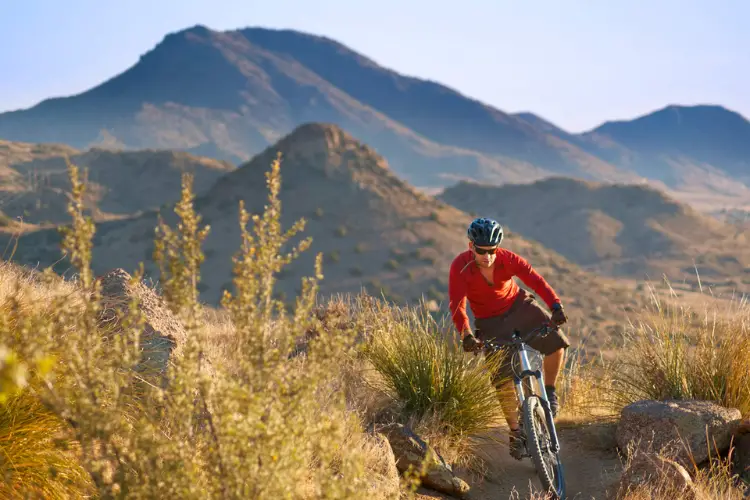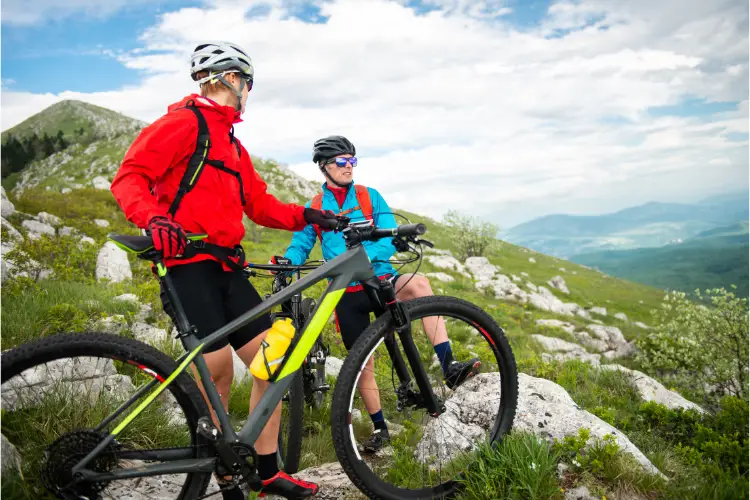Mountain biking and pavement cycling have a lot in common. They are both forms of cycling, after all.
However, there are some key differences that you should be aware of if you’re planning to take your mountain bike out on the paved roads.
In this post, we’ll discuss about Can You Ride A Mountain Bike On Pavement? and those differences and provide tips for how to make the transition from one type of riding to the other.
Quick Navigation
Can You Ride A Mountain Bike On Pavement?
Yes, You can ride your mountain bike on pavement if you want to, but keep in mind that it will be harder for pedaling and the surface is rough with traditional knobby tires.
Mountain bikes are designed to be used off-road and are engineered to be more efficient and stable than road bikes. This allows them to climb steeper grades, handle rougher terrain, and go faster through corners.
Road bikes are lighter, have lower gearing, and have smaller wheels. As a result, they are more comfortable riding on pavement because they can be ridden at a slower speed without straining their legs or back.
Additionally, road bikes offer more control over the bike’s behavior because you can use your body weight to slow down or stop the bike in an emergency situation.
If you’re trying to decide whether or not you can ride a mountain bike on pavement, it’s best to consult with a rider who knows how each type of bike works best.
In addition, you may want to consider whether or not riding on pavement is worth the risk of injury if something goes wrong with your bike during a crash or other accident.

5 Reasons Why People Ride Mountain Bikes on Pavement
Mountain bikes are the most versatile, fun to ride and comfortable to ride. They are also the most efficient way to get around when on a bike path or road.
Here are five reasons why people enjoying riding a mountain bike on pavements:
(i) It’s fun!
Pavement has a lot of bumps and cracks that cause the tires of a mountain bike to skip and slide along the surface.
However, riding on pavement allows you to explore new areas and see what your bike can do. You’ll also be able to enjoy the scenery as you go.
(ii) More efficient than cycling on trails
Mountain biking on unpaved surfaces requires less energy than riding off-road since you don’t have to pedal uphill all the time and because you can coast downhill for longer distances. This means you can go faster and spend less time cycling to cover the same distance.
(iii) Social than off-road cycling
Mountain biking on paved roads is a great way to meet other people while enjoying nature at the same time.
You can chat with the other riders, share food and drink, take breaks at scenic locations and even relax during your ride by taking a break at a coffee shop or park.
This kind of social interaction isn’t possible when you’re riding off-road, making bike packing more accessible for everyone who wants to try this sport but doesn’t have enough time or money for an epic endurance race event every weekend.
(iv) Gears work better on the pavement
When you’re riding a mountain bike, the gear shifts are much smoother than with a road bike.
This means that you can pedal the bike faster and with more power, which makes it easier to climb hills and get up from the flats.
(v) Safety
Mountain biking is safer than many other types of cycling because you’re not going in any fast or aggressive way.
So you usually don’t ride aggressively, and there’s less risk of falling over or crashing into something.
Since most people don’t have access to trails or even flat ground where they can practice their skills, using mountain bikes instead of hiking boots is a safe alternative for those who want more flexibility with their exercise routine.
How Fast Can A Mountain Bike Go On The Pavement?
The speed you can reach on a mountain bike depends on the type of bike, the terrain, and what kind of gearing you’re using.
The most common gearing setup is a front chain ring with a rear sprocket with three or four teeth. This ranges from about 30 to 80 RPM revolutions per minute.
You can also get single-speed bikes with just one gear, which works well if you’re riding trails with lots of climbing.

How Long Do Mountain Bike Tires Last On The Pavement?
The lifespan of a mountain bike tire highly depends on the rider and how they use their bicycle.
For example, if you are an aggressive rider who rides at high speeds, you will wear out your tires in a shorter period than someone who rides at slower speeds.
You can also determine how long a mountain bike tire will last by looking at the specifications on the side of the tire.
The number after the letter “R” represents the number of grams per square inch. The higher the number, the better traction that tire provides.
The most efficient way to prolong the life of your tires is to keep them from being overheated during use.
When tires are hot, they lose their elasticity which means they won’t hold air as well and therefore won’t have as much grip on wet or slick surfaces.
Mountain Bike vs Road Bike On Pavement
Mountain bikes and road bikes are both great options when it comes to riding on pavement. However, there are a few identifiable differences between them.
| Mountain bikes | Road bikes |
|---|---|
| Mountain Bikes are lighter and have smaller wheels than road bikes. | Road Bikes are heavier and have larger wheels than mountain bikes. |
| Mountain bikes are heavier and more stable, which makes them better for off-road riding. | Road bikes are lighter than mountain bikes, so they require less effort to propel themselves forward. |
| Mountain bikes have drop bars mounted on the handlebars, allowing you to lean forward when pushing yourself up hills. | Road bikes are usually equipped with flat bars, which makes them easier to control on the road. |
| Mountain bikes also have wider handlebars which allows for more upright riding positions. | Road bikes also have shorter handlebars and padded seats, making them more comfortable to ride long distances. |
Can You Ride A Mountain Bike On Pavement – FAQs
Q1: Can a Mountain Bike be Ridden on the Road?
Answer: Yes, mountain bikes can be ridden on the road.
However, they are not ideal for road riding since they are designed for off-road use. Mountain bikes have knobby tires that are great for grip and traction in mud and dirt, but they roll slower on pavement and can be more difficult to pedal.
Additionally, mountain bikes often have suspension systems that absorb shock on rough trails but can add unnecessary weight and resistance on the road.
If you ride a mountain bike on the road, keeping your speed in check and being mindful of potential obstacles like potholes and cracks is essential.
Q2: How Far Do You Ride On Pavement?
Answer: Most cyclists ride between 25 and 50 miles per week on pavement.
Pavement is a great surface for cycling because it’s relatively smooth, even, and predictable. It’s also one of the most common surfaces that cyclists encounter, so it’s important to be comfortable riding on it.
There are a few things to keep in mind when riding on pavement:
– Pay attention to the condition of the pavement. Potholes, cracks, and bumps can cause you to lose control or crash.
– Stay aware of your surroundings. Cars and other vehicles may not see you or may not know how to react around a cyclist. always be aware of your surroundings and use hand signals to indicate your intentions.
Q3: What Is The Average Speed Mountain Bike On Pavement?
Answer: The average speed for a mountain bike on pavement is around 15 miles per hour.
However, this can vary depending on the terrain and whether you are going up or downhill. Professional cyclists often train on asphalt roads to build up their endurance and speed.
Q4: If I Ride My MTB On Asphalt Is It Bad For My Tires?
Answer: It’s not necessarily bad for your tires, but it is rougher on them. Riding on asphalt instead of a trail will cause more wear and tear on your tires, so they’ll need to be replaced more often.
Closing Through on Can You Ride A Mountain Bike On Pavement
Mountain biking is a fantastic sport that everyone can enjoy.
However, getting into the sport is not always easy if you live in an area with little or no mountain bike trails.
However, mountain biking may be right up your alley if you’re looking for a way to get some exercise while enjoying the outdoors and being active.
The best way to ride a mountain bike on the road is to choose a bike equipped with pedal-assist technology.
This means that when you press down on the pedals, the motor will automatically kick in and help you propel your bike up to 15 mph.
If you have to ride on pavement, wear a helmet and pads.
